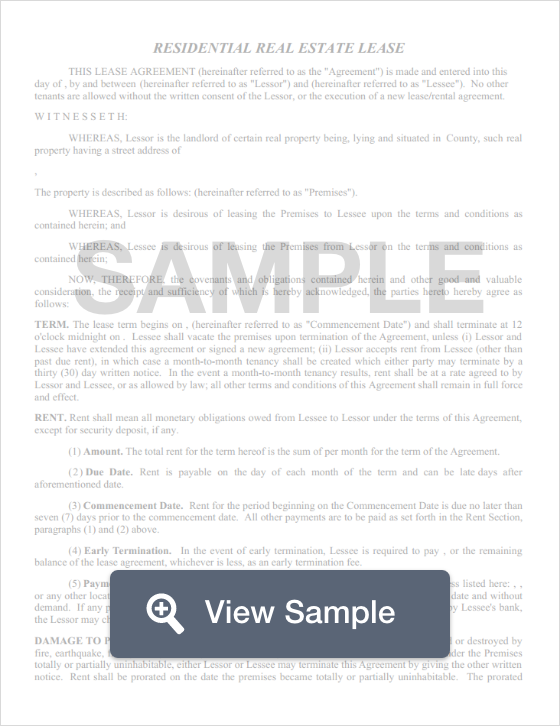Make a South Dakota Lease Agreement
Create a South Dakota Lease Agreement with our customizable template!

What Is a South Dakota Lease Agreement?
A South Dakota lease agreement is a legally binding real estate contract between the landlord or property management company and the tenant(s) interested in a specific rental unit. After the contract is signed and dated by the parties, the tenant may take legal possession of the property and move in. A South Dakota lease agreement may be used for a residential or commercial property.
Looking for other South Dakota documents?

Business
- South Dakota Non-Compete Agreement
- South Dakota Non-Disclosure Agreement
- South Dakota Promissory Note

Personal
- South Dakota Last Will and Testament
- South Dakota Living Will
- South Dakota Power Of Attorney

Real Estate
- South Dakota Bill Of Sale
- South Dakota Eviction Notice
- South Dakota Month-to-Month Lease Agreement
- South Dakota Quit Claim Deed
- South Dakota Rental Application
- South Dakota Sublease Agreement


Sample South Dakota Lease Agreement


Search Documents
Related Documents
Looking for other South Dakota documents?

Business
- South Dakota Non-Compete Agreement
- South Dakota Non-Disclosure Agreement
- South Dakota Promissory Note

Personal
- South Dakota Last Will and Testament
- South Dakota Living Will
- South Dakota Power Of Attorney

Real Estate
- South Dakota Bill Of Sale
- South Dakota Eviction Notice
- South Dakota Month-to-Month Lease Agreement
- South Dakota Quit Claim Deed
- South Dakota Rental Application
- South Dakota Sublease Agreement
Most Commonly Used Lease Agreements
The most commonly used South Dakota lease agreements are standard residential lease agreements, month-to-month lease agreements, lease with an option to buy, roommate agreements, sublease agreements, and a commercial lease agreement.
The most commonly used South Dakota lease agreements share the majority of the same elements although they do have their own features as well. Here are a couple of examples.
- A roommate agreement is a type residential lease agreement. In addition to relying on the same elements of a residential lease, it also explains which areas of the rental are for the sole use of the roommate and which areas may be used by all occupants.
- A standard residential lease agreement is generally written for a term of one year. When that year ends, it may automatically renew for another year or it may convert to a month-to-month lease agreement. A standard residential lease agreement written for a term of one year and a month-to-month lease still have similarities. One of the most common similarities is their reliance on the requirement of a written 30-day notice to move out of the property at the end of the agreement if either party does not plan to renew the lease agreement.
How to Write a South Dakota Lease Agreement
A South Dakota lease agreement must follow the state’s landlord-tenant laws. Otherwise, the contract cannot be enforced. There are other laws that must be considered as well. You’ll learn more about many of those under the sections related to disclosures and security deposits.
Before signing a South Dakota lease agreement, read it carefully or have it reviewed by an attorney.
A South Dakota lease agreement requires the following:
- Names of the Parties - This is the landlord’s legal name or the property management company’s legal business name as well as the legal name of the tenant(s).
- Property Address - This is the full street address for the rental property. It includes the city, zip code, and, if applicable, the unit number or lot number.
- Term Information - This is the type of lease agreement the parties agree to enter into regarding the rental property. For example, a month-to-month lease or a fixed term. A fixed-term lease means that the parties agree that the tenant will hold possession of the rental for a certain amount of time, usually one year. If it is a fixed lease, this section should include the date the lease ends.
- Rental Amount - This section includes the date the lease begins, the amount of the monthly rent, the day of the month rent is due, and the address where the rent may be paid.
- Late Fee -This section documents the amount of the fee that is due if the rent is not paid by a certain date.
- Security Deposit - This is the amount of money the tenant must pay in advance of taking control of the property. The security deposit is used to repair damages caused by the tenant.
- Initial Payment - This is the total amount of money the tenant must pay to move into the rental. It includes the amount of the first month’s rent, the security deposit, and the total of the two numbers added together.
- Occupants - This section includes the full name of each tenant even if the tenant is a minor or they are not signing the lease. This part of a South Dakota residential lease agreement establishes who will reside in the residential unit. For commercial space leases, it designates who has permission to use the space. If the presence of additional occupants changes the price of the rent, it should be included in this section.
- Utilities - This section explains which utilities or services a tenant does not pay.
- Parking - This section informs the tenant if they will receive a parking space. If a parking space is reserved and there is a designated spot, the spot should be listed in this section.
- Furnishings - This section explains to tenants what they may install, such as a washing machine or dishwasher, or what they may not install. If the tenant is not allowed to bring their own appliances, that should be designated in this section.
- Notices - This section documents the names of the landlord or property manager and the tenant along with their mailing address. This information is used if the parties need to send out a notice to the other party.
- Eviction - This section informs the tenant how eviction would be carried out in the event of nonpayment of rent or breach of other lease terms.
- Additional Terms - This section lists any other terms that the parties agreed to include but aren’t found anywhere else in the lease agreement.
- Signature and Date - The document should be signed and dated by the parties.
Which Disclosures Belong in a South Dakota Lease Agreement?
South Dakota landlords must disclose to tenants whether the rental property was ever used as a methamphetamine lab. Under federal law, if the residential property was constructed before 1978, the tenant is entitled to a disclosure about the possibility of lead paint.
What You Need to Know About South Dakota Lease Agreement Deposits?
Under South Dakota landlord tenant law, the most a landlord may request as a security deposit is one month's rent unless the landlord can prove that the tenant is more likely to cause damage or create a danger to the premises. State law also requires that a security deposit must be returned to the tenant within 14 days of the end of the lease unless the landlord is withholding part of the deposit for damages. Then, they have 45 days and must provide a list of itemized deductions. If the landlord fails to provide the itemized list of deductions, they can be fined up to $200.

Create a South Dakota Lease Agreement in minutes with our professional document builder.













